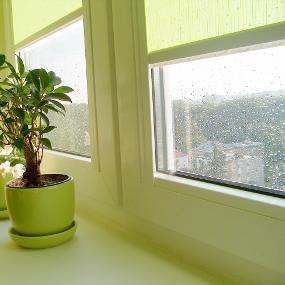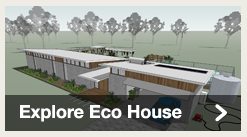Build it Back Greenbushfires
Glazing
 Poorly
planned or wrongly sized windows can either let in unwanted heat,
or hamper the flow of fresh air into your home. However, thanks to
some clever new technologies, windows no longer have to be a
compromise between getting enough light and keeping the house at a
comfortable temperature. Some types of glass can help make your
windows more energy efficient.
Poorly
planned or wrongly sized windows can either let in unwanted heat,
or hamper the flow of fresh air into your home. However, thanks to
some clever new technologies, windows no longer have to be a
compromise between getting enough light and keeping the house at a
comfortable temperature. Some types of glass can help make your
windows more energy efficient.
Tinted or toned glass is coloured glass that acts like sunglasses to reduce the amount of heat and light entering your home.
Reflective glass has a coating that reflects heat and light away from the window. Double-glazed windows are window units with two panes of glass and a sealed air gap in between. These are far superior to single-glazed windows for insulating your home.
Low-emissive (low-e) glazing is a glass coating that blocks radiant heat transfer (heat waves given off by hot objects). It acts like a 'heat mirror', reflecting heat back into a room in winter, while letting sunlight in from outside.
Spectrally selective glazing allows some wavelengths of energy to pass through but reflects others; for example, it will transmit light but not heat. It is often used for warmer climates or west-facing windows when trying to minimise heat from the sun.
If you're wondering whether the added cost of improved glazing is worthwhile, then consider this: compared to single-glazing, a double-glazed window could cut your heat loss in half.
To help you make the right choice, the Window Energy Rating scheme (WERS) rates the energy performance of windows and gives them a star rating according to their heating and cooling performance. Look for the WERS label when selecting a window and choose the window with the highest star rating for your climate and budget.
Another important factor that affects your window performance is the type of window frame you use.
Basically, if your framing material is a good heat conductor, it will let the heat in during summer and let the heat escape during winter. Aluminium frames are very good conductors and dark-coloured frames in full sun can become hot to touch. Examples of frames with good insulating qualities include timber frames (though these require regular maintenance), aluminium frames with thermal breaks, 'combination' frames that have aluminium on the outside and timber on the inside, and PVC frames.
The new Bushfire Attack Level (BAL) has been designed to improve the ability of buildings to withstand a bushfire attack and has six levels of risk based on the BAL, with increasing construction requirements ranging from ember protection at the low levels to fire-rated construction at the highest.
For brick veneer homes no special construction requirements are required by AS3959-2009 for the wall or floor frames; and as such, all commonly used timber products are appropriate for all wall studs & lintels and floor joists, bearers and flooring.
For windows, the new requirements range from installing thicker toughened glass to bushfire shutters or bushfire-approved window frames. The material of a window frame can affect overall window performance, and in many cases, be mandated for a higher bushfire protection BAL. Australian hardwoods and PVC meet many requirements at lower bushfire levels however only a selected number of timber species (listed in AS 3959-2009) will meet higher bushfire requirements and these are: Blackbutt, Spotted Gum, Silvertop Ash, Kwila (Merbau), Red Ironbark, River Red Gum; Turpentine. Aluminum or steel frames meet most requirements for bushfire protection, but other criteria emerge if seeking better thermal performance.
Consult with your building inspector to ensure he/she will be comfortable signing off on whatever products you select. Ensure windows requiring bushfire testing have been tested in NATA-accredited testing facilities and manufacturers/suppliers can supply full test reports.
It is important that your building designer incorporates the new standard when designing your home. The new requirements can be found on the Building Commission's website or you can call the Bushfire Building Advice line on 1300 360 320 for more information.
Suppliers
Brax - www.braxwt.com.au
Ph. 03 5221 5533
CertainTeed - www.certainteed.com.au
Ph. 1800 062 100
Clear Comfort - www.clearcomfort.com.au
Ph. 02 6161 3570
Ecovue - www.ecovue.com.au
Ph. 02 9648 1777
Everglaze - www.everglaze.com.au
Ph. 03 9499 8055
Magnetite - www.magnetite.com.au
Ph. 03 9338 4445
Miglas - www.miglas.com.au
Ph. 03 9728 3999
Paarhammer - www.paarhammer.com.au
Ph. 1300 655 920
Pickering Windows - www.pickeringwindows.com.au
Ph. 03 5243 4166
Rylock - www.rylock.com
Viridian - www.viridianglass.com
Listed suppliers are a guide and are not endorsed by Green Cross Australia or the Alternative Technology Association.




